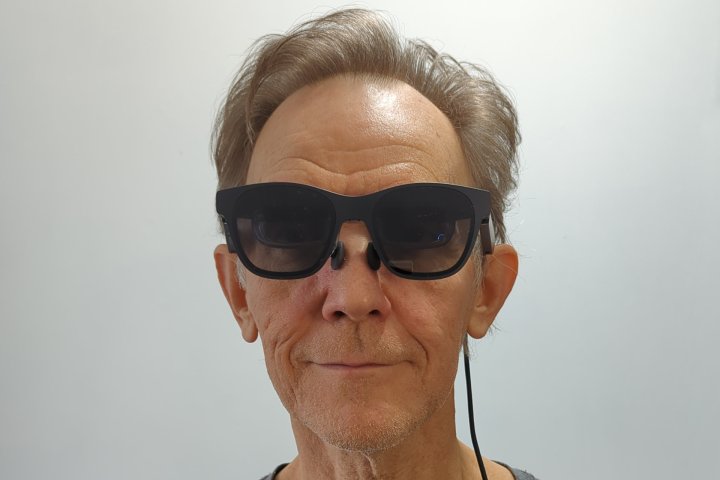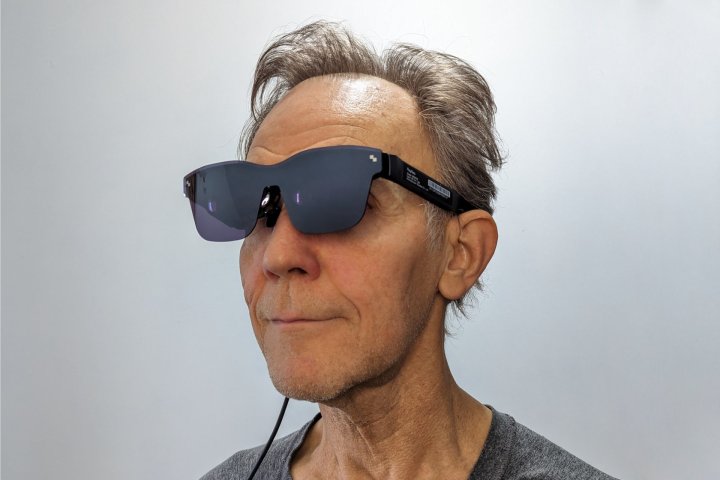If you’ve been thinking of smart glasses as a technology of the future, you should take a closer look. You can find top-quality glasses that are as light and comfortable as sunglasses right now. Some smart glasses present large, vivid displays, letting you carry a theater experience in your pocket. Others feature AI chat to keep you informed and provide creative tips anywhere you go. There are even smart glasses that record video and take great looking photos.
If you wear corrective lenses, you can order these smart glasses to match your prescription. Let’s explore the best and most affordable smart glasses for different devices and uses.

Ray-Ban Meta Smart Glasses
Best smart glasses for photos and videos
- Lightweight and stylish glasses
- Hands-free photo and video capture
- Good 12MP photos
- HD+ videos
- Live-streaming capability
- Good speaker quality
- Impressive five-mic array
- Meta AI chatbot
- No display
- 1-second shutter lag
Camera glasses might sound like a bad idea at first, but Meta worked magic with the smart glasses it made with Ray-Ban. You can take 12MP photos that usually look as good as you get from a flagship phone. In low light, your phone will win, but it’s hard to beat the convenience of verbal, hands-free photos and videos while enjoying a beautiful day outdoors.
The video quality is also surprisingly good, though it’s in portrait orientation. That means you’ll need to take the Ray-Ban Meta Smart Glasses off and hold them sideways to get a wide-screen video or crop into the 6MP portrait shot if you want 16:9 format.
Besides video and photo capture, Meta AI is free in supported areas, responding to your questions with quick answers through the earpieces. The speakers also have good directional volume, so the replies are discrete. You can also play music or listen to podcasts without the sound disturbing others.
Even more exciting, multimodal AI is rolling out in April 2024, so your Ray-Ban Meta Smart Glasses will soon be able answer questions about what you’re looking at. Meta AI is currently only available in the U.S. but will be available in more countries eventually.
The Ray-Ban Meta Smart Glasses start at $370, which would be expensive for AI glasses. But as more and more features roll out, the value keeps increasing.


Viture One
Best display smart glasses for the iPhone
- iPhone app offers a multi-screen desktop
- Electrochromic dimming
- Also works with Android and macOS
- FOV is small
- A bit heavier than others
If you own an iPhone, check out the Viture One, the only smart glasses with an iOS app that launches as a multiwindow desktop. With the Spacewalker app, your iPhone becomes a laser pointer that you use to select what video to watch or browse the web. You can swipe text with your iPhone keyboard or use voice typing.
The displays are bright and vivid enough to see clearly indoors. When you move to a brighter location, you can dim the background with the press of a button. Two dials above each eye let you fine tune the focus up to -5.0 diopters for myopia. The extra optical hardware make these smart glasses a bit heavier, but 2.8 ounces is still comfortable for an hour or two.
The 43-degree field of view (FOV) isn’t quite as wide as others on this list; that’s equivalent to a 120-inch TV that’s 10 feet away. Viture One displays 1920×1080 video at 60 Hz. The specs list a display brightness of 1,800 nits. After passing through the optics, you get about 500 nits to the eye.
Viture One recently released the Spacewalker app on Android and a limited beta version for macOS. Like most other smart glasses with displays, you can also connect the Viture One to any device that supports USB-C Alt mode to display a single large virtual screen.
I’m currently testing the Viture One and quite pleased with the picture quality, ease of use, and the functionality of the Spacewalker app on all three platforms. Stay tuned for an upcoming review where I’ll explore using the Viture One as a spatial computer.
If the $439 starting price for Viture One is too expensive, the new $349 Viture One Lite lack only the electrochromic environment dimming feature.


Xreal Air 2
Best for the Samsung and Android
- Lightest display glasses available
- Multi-screen apps for Android, macOS, and Windows
- An electrochromic model is available
- No iPhone app
- Not the brightest or widest FOV
There’s a reason Xreal is the best-selling smart glasses manufacturer. It’s Air 2 smart glasses have great displays and feature the Nebula app, which lets you view multiple virtual screens on many Samsung and some other Android phones.
The Air 2 boast top-tier specifications, packing a lot of tech. Still, Xreal managed to make them the lightest smart glasses on the market. I found the Xreal Air 2 comfortable and lightweight enough to wear for several hours — perfect for a long movie.
Xreal’s Nebula app is also available for macOS and there’s a high-quality Windows beta as well. Xreal’s Air 2 also works with USB-C Alt mode devices for screen mirroring. You can also use Dex, if preferred, on supported Samsung phones and the Xreal Air 2 will display the desktop.
At $399, the Xreal Air 2 feature a wide 46-degree FOV, up to 120 Hz refresh rate, and 500 nits of brightness while weighing just 2.5 ounces. For $50 more, the Xreal Air 2 Pro add electrochromic dimming to lower ambient light, so videos have good contrast in bright rooms.


RayNeo Air 2
Best display smart glasses for outdoor use
- Built-in sun shade
- Lightest weight with dimming
- Multiscreen app for Android
- Ambient light is always dimmed
- Only supports Android
RayNeo’s Air 2 smart glasses have 600 nits of brightness and come with a built-in shade, dimming your surroundings a bit. That combination makes outdoor use very convenient. You need to clip on a shade or pay extra for electrochromic dimming with most smart glasses to avoid videos fading out when viewed in sunlight.
Your room will look a bit dark through the lenses, but if you’re watching a video, you probably aren’t too concerned about what’s happening around you.
At $379, the RayNeo Air 2 are among the most affordable, yet full-featured video glasses available. Refresh rates up to 120 Hz are supported, the FOV is 46 degrees and weight is 3.7 ounces.
The RayNeo AR app provides a multiscreen experience for Android phones that support USB-C Alt mode.


Rokid Max
Best display smart glasses for myopia
- Largest virtual screens
- Great image quality
- Up to -6.0 diopter adjustment
- Narrower lenses let you see below
- Rokid Station accessory runs Android TV
- No partial dimming option
- Rokid app only supports Android
If you wear prescription lenses for myopia, the Rokid Max smart glasses have dials for vision correction up to -6.0 diopters. With bright 600-nit displays at 120 Hz and an ultra-wide 50-degree FOV, the image quality is among the best.
The Rokid Max’s almond-shaped lenses eliminate unnecessary bulk, exposing more of your environment and cutting weight to just 2.6 ounces. If the background becomes distracting, you can attach the included, fully opaque cover that has the more traditional sunglasses shape.
If you own an Android phone that supports USB-C Alt mode, the Rokid AR app can display multiple browser windows with an interface similar to the brands mentioned above. For $399, the Rokid Max turns your phone into a big screen TV and mobile workstation.


Amazon Echo Frames
Best smart glasses for smart homes
- Good volume with minimal leakage
- Nice audio quality for open-ear speakers
- Excellent call quality
- Access to the Amazon ecosystem
- Not locked in to a specific device
- No charging case
- Expensive compared to earbuds
If you have an Alexa-powered home, it’s worth considering Amazon Echo Frames. The third generation is better than ever and provides Amazon’s Alexa assistant in a 1.3-ounce pair of glasses. Like Meta and Solos, there are a variety of frame styles and colors in clear and sunglasses form.
Like any Echo device, you can control Alexa-compatible smart home devices, play music, order products, and run routines from Amazon’s smart glasses. It’s quite a robust ecosystem, making the $270 Echo Frames a good choice for Prime members that use Alexa.
Amazon said Alexa would get an upgrade with generative AI features in the future but hasn’t announced a release date. For now, think of the Echo Frames as a lightweight pair of smart glasses that run Alexa and have good sound quality for music and podcasts.


Solos AirGo 3
Best AI smart glasses for travel and other countries
- Lightest smart glasses
- Good volume level
- Includes ChatGPT
- Translates 25 languages
- Inexpensive
- Some audio leaks even at medium volume
- No camera
If you travel often, Solos AirGo 3 might be the best choice. A dedicated translation mode facilitates conversations in 25 languages, including English, Arabic, Cantonese, Czech, Dutch, French, German, Greek, Hindi, Indonesian, Italian, Japanese, Korean, Mandarin, Philippines, Polish, Portuguese, Putonghua, Russian, Spanish, Swedish, Thai, Turkish, Ukrainian, and Vietnamese.
These 1.1-ounce smart glasses also include ChatGPT so you get high-quality AI assistance and creative inspiration. The sound quality is nice, and the AirGo 3 have stronger speakers than Meta’s smart glasses, making it easier to hear in noisy environments.
Solos includes ChatGPT for free, but a premium subscription unlocks a voice assistant that sounds more like a human and you get an extended ChatGPT history in the mobile app.
Starting at $249, the Solos AirGo 3 are an inexpensive way to bring AI and translation with you wherever you go.

Frequently Asked Questions
If you’ve never tried smart glasses with displays, prepare to be surprised by the picture quality. It’s like looking at a translucent big screen TV that hovers in front of you wherever you go. You can even watch 3D movies with this wearable technology.
A $400 pair of smart glasses can’t compete with a $3,500 Apple Vision Pro, but glasses are easy to carry around so you can pass the time enjoying a movie or catching up on the latest news while you wait for meet ups or appointments. The tradeoff is sharpness. The best smart glasses have great clarity but display video at 1080p. For 4K resolution, you need an expensive VR headset, a nice monitor, or a 4K TV.
Naturally, speakers are built-in so you can listen to videos with the glasses. The volume levels are adjustable and audio quality is good for every model on this list. Smart glasses with displays are heavier than sunglasses, but the top brands remain comfortable for long enough to enjoy a movie.
Until recently smart glasses couldn’t record high-quality video or take pictures that could compete with a flagship phone. The latest models of camera smart glasses let you capture video from your own point-of-view, making it easy to share your daily life and memorable experiences with a simple voice command or button press.
You might miss a rare opportunity for a photo by the time you take out your phone and open the camera app, but smart glasses with a camera are always ready to catch that elusive bird or special smile that would otherwise be lost.
Meta is leading the way and the viral popularity of Ray-Ban Smart Glasses will bring competitors soon enough.
In the era of ChatGPT, AI is infusing everything, including smart glasses. These wearables provide information and inspiration within seconds of your request. Best of all, your AI assistant works hands-free so you can get help while driving, chopping vegetables, or carrying packages.
For most AI smart glasses, you ask a question aloud and receive an audible reply from a voice assistant. However, some smart glasses can accept visual input. AI glasses tend to be much lighter than smart glasses meant to display giant screens.
If you’re looking for something more exciting, some of the top manufacturers have high-tech solutions that go beyond the basics. We haven’t reviewed models with integrated displays, spatial awareness, and AI, but those capabilities are available if you can afford the cost.
The $699 Xreal Air 2 Ultra and $899 RayNeo X2 push technology beyond the limitations of most display glasses and closer to AR glasses. Lower cost models, default to a single central display and browser apps allow you to look around to see more screens.
Xreal and RayNeo include some spatial computing capabilities to track your position in a room and anchor virtual screens in place when you move around. It’s not like wearing an Apple Vision Pro or a Meta Quest 3, but this is the beginning of AR glasses technology.
We haven’t had a chance to review these next-level smart glasses, but both sound amazing despite the expense. Be aware that integrating tracking cameras, larger batteries, and the other technology needed to enable advanced features adds weight.
While the best smart glasses on the market have gone through two to three generations, and were already useful in 2023, AR glasses are still at the early stages of development and might be best suited for early adopters and developers.
If you’re shopping for your first pair of smart glasses, it’s safer to try the more affordable and lighter models to get a sense of your comfort level. As with any glasses, it could take a few days to refine the fit. Most come with more than one set of nose pads and the bridge and ear tips are often adjustable.
For smart glasses with displays, wearing them higher or lower can improve image clarity. It’s also important to understand the controls for volume and brightness. With AI smart glasses, you might be able to customize the voice and adjust notifications passed through from your phone.
This is the right time to consider buying smart glasses. From accessing AI and recording videos without taking out your phone to enjoying a big screen experience away from home, there’s a diverse and growing list of smart glasses to match your exact needs.
Editors’ Recommendations
Services Marketplace – Listings, Bookings & Reviews
